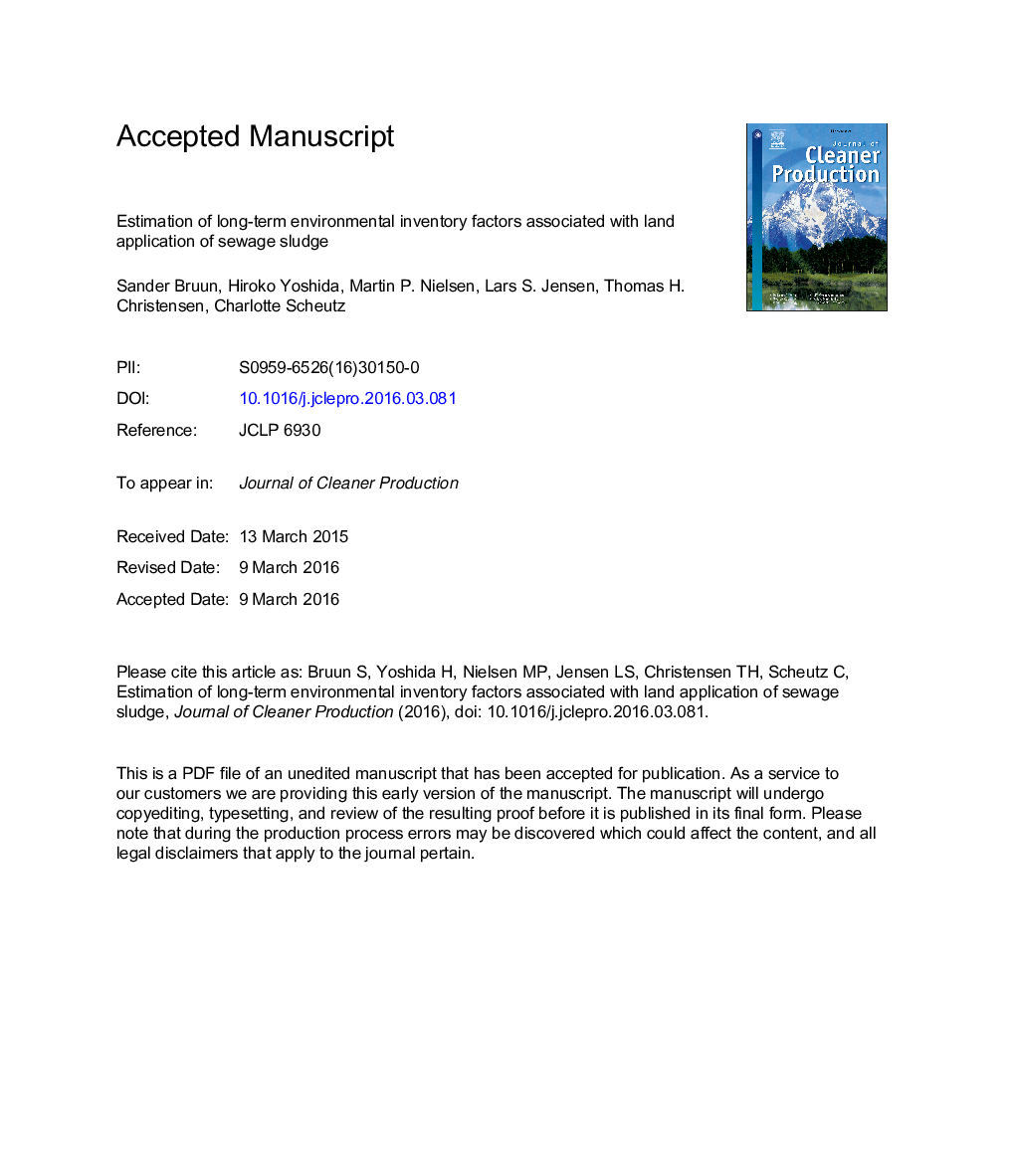| کد مقاله | کد نشریه | سال انتشار | مقاله انگلیسی | نسخه تمام متن |
|---|---|---|---|---|
| 8102138 | 1522123 | 2016 | 35 صفحه PDF | دانلود رایگان |
عنوان انگلیسی مقاله ISI
Estimation of long-term environmental inventory factors associated with land application of sewage sludge
ترجمه فارسی عنوان
برآورد فاکتورهای موجود در محیط زیست درازمدت با استفاده از لجن فاضلاب زمین
دانلود مقاله + سفارش ترجمه
دانلود مقاله ISI انگلیسی
رایگان برای ایرانیان
کلمات کلیدی
ترجمه چکیده
استفاده لجن از لجن فاضلاب تعدادی از مزایای دیگر را دارد، اما همچنین با اثرات زیست محیطی مرتبط است. برای ارزیابی مناسب از روش های مختلف لجن، بسیار مهم است که برآوردهای قابل قبولی از انتشار پس از استفاده از انواع لجن مختلف داشته باشیم. با این حال، به دلیل پیچیدگی سیستم تولید محصولات کشاورزی، تخمین زده می شود که در شرایط مختلف متفاوت است. در مقاله حاضر، مدل کشاورزی اکوسیستمی مکانیسم کالیبره شده بود تا قادر به شبیه سازی انواع مختلف لجن با استفاده از تکنیک های مختلف است. در ادامه، شبیه سازی مدل 100 ساله برای ارائه فاکتورهای انتشار و همچنین عوامل برداشت و کربن (در مجموع عوامل فاکتور موجودی محیط) در شرایط مختلف محیطی مورد استفاده قرار گرفت. فاکتورهای موجودی محیطی تحت هر دو شرایط پاسخ بالا (به عنوان مثال زمانی که نیتروژن محدود شد) و شرایط پاسخ کم محصول (یعنی زمانی که نیتروژن محدود نمی شد) محاسبه شد. میانگین ضریب برداشت پاسخ نیتروژن در شرایط محیطی آزمایش شده از 06/0 تا 30/0 برای انواع لجن مختلف شامل بود. این بدان معناست که اگر یک لیتر اضافی 1 گرم در لیتر نیتروژن با لجن تزریق شود، بین 0.06 تا 30.30 گرم نیتروژن اضافی اضافه می شود. این مقدار به طور معنی داری کمتر از کود معدنی با میانگین 0.63 می باشد. فاکتورهای برداشت پاسخ کم، بطور قابل توجهی پایینتر از 03.03 تا 0.13 بود. فاکتور انتشار نیتروژن اکسید نیتروس از 0.024 تا 0.034 محاسبه شد که به طور مداوم در شرایط پاسخ بالا بالاتر بود. برای شستشوی نیتروژن به آبهای زیرزمینی، فاکتور خروج واکنش بالا از 0.20 تا 0.50 برای انواع مختلف لجن بود، در حالی که پاسخ کم، کمی بالاتر از 0.18 تا 0.55 بود. میانگین ضریب جذب کربن در شرایط مختلف محیطی از 0.03 تا 05.05 برای انواع مختلف لجن متفاوت بود. در نتیجه، رویکردی که با استفاده از یک مدل کشاورزی-اکوسیستم برای تخمین عوامل موجود در ارتباط با استفاده از زمین لجن در شرایط مختلف، بسیار قدرتمند بود و با استفاده از ابزار تجربی غیرممکن بود.
موضوعات مرتبط
مهندسی و علوم پایه
مهندسی انرژی
انرژی های تجدید پذیر، توسعه پایدار و محیط زیست
چکیده انگلیسی
Land application of sewage sludge has a number of advantages over other alternatives, but is also associated with environmental impacts. To make proper assessments of different sludge treatments, it is crucial to have reliable estimates of emissions after the application of different sludge types. However, because of the complexity of the agricultural production system, it is difficult to estimate emissions consistently under different conditions. In the current paper, a mechanistic agro-ecosystem model was calibrated to be able to simulate different sludge types stabilized using different techniques. Subsequently, 100 year model simulations were used to provide emission factors as well as harvest and carbon sequestration factors (collectively called environmental inventory factors) under a variety of environmental conditions. Environmental inventory factors were calculated under both high crop response conditions (i.e. when nitrogen was limiting) and low crop response conditions (i.e. when nitrogen was not limiting). The average high response nitrogen harvest factor over the tested environmental conditions was ranging from 0.06 to 0.30 for the different sludge types included. This means that if an additional 1Â kg of nitrogen is applied with sludge, between 0.06 and 0.30Â kg additional nitrogen is harvested. This is considerably lower than for mineral fertilizer with an average value of 0.63. The low response harvest factors were considerably lower, ranging from 0.03 to 0.13. The emission factor for nitrous oxide nitrogen was ranging from 0.024 to 0.034, consistently being higher under high response conditions. For nitrogen leaching to the groundwater, the high response emission factor ranged from 0.20 to 0.50 for the different sludge types while the low response were slightly higher ranging from 0.18 to 0.55. The average carbon sequestration factor across the different environmental conditions ranged from 0.03 to 0.05 for the different sludge types. In conclusion, the approach using an agro-ecosystem model to estimate inventory factors associated with land application of sludge under varying conditions proved very powerful and would have been virtually impossible by experimental means.
ناشر
Database: Elsevier - ScienceDirect (ساینس دایرکت)
Journal: Journal of Cleaner Production - Volume 126, 10 July 2016, Pages 440-450
Journal: Journal of Cleaner Production - Volume 126, 10 July 2016, Pages 440-450
نویسندگان
Sander Bruun, Hiroko Yoshida, Martin P. Nielsen, Lars S. Jensen, Thomas H. Christensen, Charlotte Scheutz,
